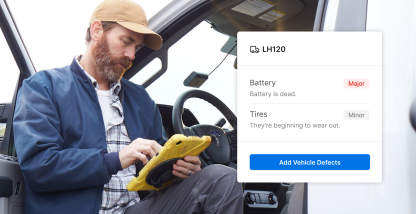Most fleets and drivers are expected to abide by the hours-of-service rules defined by the FMCSA. The ELD mandate is also another step to ensure that nobody violates the HOS rules, which plays a vital role in improving safety and reducing road accidents. ELDs also have the added benefit of preventing driver coercion.
The problem is that some fleet managers and commercial drivers bend those rules and violate the HOS regulations. Commercial drivers are often at a loss here.
As RODS are maintained on paper logs, they are easily manipulated. As a result, some fleet managers often coerce drivers into driving beyond their HOS limits, more than they are supposed to drive. Without a proper logging system, drivers end up submitting.
The good news for drivers is that electronic logging devices and the upcoming ELD mandate prevent driver coercion to a large extent.
In this blog post, we take a look at how ELDs can help prevent driver coercion.
Learn how to streamline your driver logs and electronic logbooks.
4+ ways ELDs help prevent driver coersion
1. ELDs show the unassigned driving time
An ELD records every mile covered by the vehicle and assigns them to drivers. If there are miles that are not assigned to a driver, ELDs mark them as ‘unassigned driving time’.
Every time a driver logs in to the electronic logging device, the ELD displays the unassigned driving time. If a driver is responsible for the unassigned driving time, he can simply mark that time as his own. The driver’s Record of Duty Status (RODS) will be then automatically adjusted.
If there remains any unassigned driving time, it is questionable under the law. Fleet managers will have to ask the specific driver who drove the vehicle at that time to accept the unassigned driving time.
If a fleet manager is coercing drivers into driving more than their HOS limits, it will reflect into the records because of this.
2. ELDs require driver verification for edits
ELDs give a great deal of authority to drivers over their logs. No one can make any edit in their RODS without their consent.
Fleet managers can make edits to a driver’s records. However, all those edits are subject to the approval or rejection of the driver. Unless the driver verifies an edit in his RODS, the ELD will not make any change in the record.
The fact that drivers have the final say on edits and RODS makes driver coercion very difficult.
3. ELDs preserve the edit history
ELDs also preserve the edit history which shows all edits made, the timing of edits, and the person who made the edits.
A driver can report driver coercion using the edit history file as evidence if he is forced into driving beyond his limits and violating the hours of service regulations.
4. Drivers can file driver coercion complaints
Under the ELD mandate, the FMCSA gives drivers the opportunity to file driver coercion complaints.
The FMCSA recommends that complaints should be filed within 90 days of the coercion incident. Drivers are recommended to present ELD records, emails, chats, etc. as evidence.
In case driver coercion is proved, the motor carrier can be handed a penalty of up to $11,000.
A few more benefits of ELDs
ELDs are going to play a vital role in preventing and eliminating driver coercion. However, that’s not the only benefit of electronic logging devices.
The FMCSA estimates that using ELDs will save the industry nearly $1.6 billion through reduced paperwork and administrative burden. Fleets can also leverage the automation that ELDs provide and automate several administrative tasks, e.g., IFTA calculation.
Fleets can also reduce fuel wastage with the help of idle-time tracking, improve vehicle maintenance with vehicle diagnostics and fault-code alerts, and improve fleet safety by identifying dangerous driving behaviors.
Try Motive
Learn more about Motive, a reliable and FMCSA-registered ELD solution. More than 1 million registered drivers and 60,000 carriers rely on Motive for their compliance and fleet management needs.







